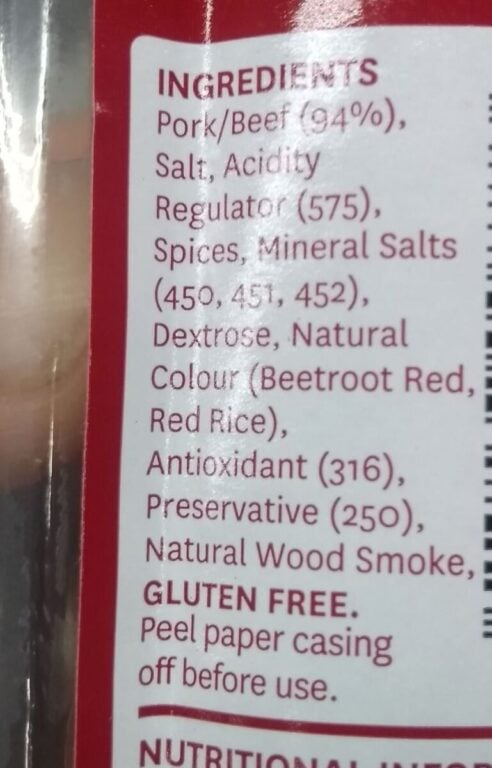Whether salami contains carbohydrates isn’t a simple yes-or-no answer. I’ve been making and studying salami for decades — visiting traditional producers across Europe and working through the technical process myself. And in that time, I’ve learned that not all salami is created equal.
In short, many mass-produced salamis include carbs due to added starches, sugars, and fillers, while traditional dry-cured salami is often very low in carbohydrates or completely carb-free.
Let’s break it down with a helpful comparison, and I’ll walk you through how fermentation, fillers, and factory shortcuts can impact the carb content of salami — and how to choose what fits your lifestyle or diet best.
To start, here’s a breakdown of the estimated carbohydrates found in various types of salami. These are based on nutritional averages per 100g from scientific and product sources.
| Salami Type | Carbohydrates (g) | Sugars (g) |
|---|---|---|
| Hard Salami | 0–2.5 | 0–0.9 |
| Genoa Salami | 0–2.8 | 0–2.5 |
| Milano Salami | 0.9–2.5 | 0–2.4 |
| Soppressata | 0–2.3 | 0–0.9 |
| Pepperoni | 0–4.0 | 0–2.0 |
| Italian Dry Salami | 0–3.0 | 0–0.9 |
| Cotto Salami (Cooked) | 0–3.2 | 0–0.9 |
Note: These are average estimates per 100g. Actual values depend on specific brands and ingredient choices. Always check product labels when in doubt.

So what’s behind these numbers? The ingredients and the process — and that’s where traditional salami stands apart from what you find in most supermarkets. In the next section, I’ll dive into the key differences between handmade and commercial salami, and where carbs come into play.
Where Do Carbs in Salami Come From?
In traditional salami, carbohydrates usually serve one purpose: to feed starter cultures for fermentation. In most of my dry-cured salami recipes, I use dextrose or a natural sugar like honey — not for sweetness, but to initiate that tangy fermentation you sometimes taste in artisanal salami.
Fermentation lowers the pH and raises acidity, which helps preserve the salami naturally. The sugars are eaten by lactic acid bacteria, which means very little remains in the finished product.
That’s the traditional route — but modern commercial salami takes a different path. Instead of relying on time and natural drying, manufacturers add fillers that happen to be carbohydrates: modified starch, soy protein, and even flour derivatives.

I snapped that photo at a local supermarket. You can see a long list of additions — many of which contribute extra carbs and have nothing to do with curing or flavor.
These ingredients are common in fast-processed salami:
- Starch and modified starch (carbohydrate fillers)
- Gums and cellulose (for binding and texture)
- Soy protein or whey powder (bulk and mouthfeel)
- Extra sugars beyond fermentation use
Some of these additives help salami dry faster by lowering water activity, but others are just there to stretch the meat — less pork, more filler. The result? A cheaper product with more carbs and less flavor.
If you want to go deeper into what makes up real salami, I broke it down with photos in this detailed article on salami ingredients.
The difference isn’t just in ingredients — it’s also in process. A real dry-cured salami can take 1–4 months to lose 35–40% of its weight and become shelf stable. A factory salami might be heat-processed and shipped the next day.
This contrast shows up in everything from texture to shelf life — and especially in carb content.
If you’re storing cut or whole salami, I wrote a full breakdown of how long different salami lasts and the best ways to keep it fresh.
Why Are Carbohydrates Added to Salami?
In traditional salami making, there’s no need for extra starches or carbohydrate fillers. But in commercial salami, these additives are often used to lower cost, tweak texture, and improve shelf life. I’ve broken this down based on what I’ve seen from producers I’ve studied and ingredients I’ve come across over the years.
Starch & Modified Starch in Cheap Salami
In cheaper salami, carbohydrates aren’t just there for fermentation — they’re used as functional ingredients. Here’s what they do:
Improved Texture & Mouthfeel
Modified starch holds onto water, creating a moister, softer texture. These tiny “moisture pockets” make the salami feel juicier even though it’s been aggressively dried or heated. The result is a semi-firm bite with artificial softness.
Profit from the Product
This is the biggest driver. Starch costs less than pork fat or lean meat. If a company can reduce meat by 5% and replace it with hydrated starch, they’ve just cut costs while increasing the weight of the final product.
Some additives allow meat to hold extra water — another cost-saving trick. Less meat, more retained water equals higher profit margins.
As a Fat Substitute
Low-fat salami often replaces fat with modified starch. This lets the manufacturer use a “reduced fat” label — even though you’re still getting a heavily processed product. Personally, I think if you’re after real salami, the fat is non-negotiable. It’s part of the flavor and mouthfeel.
Increased Shelf Life
Carb-based additives can stabilize moisture and reduce water activity. This delays spoilage and extends how long the salami can sit in stores. But again — it’s more about business than better food.
“Powdered cellulose was the first type of fiber applied because it is one of the most abundant organic materials on earth.”
ScienceDirect – Salami
These additives aren’t harmful by default — but they shift the goal from quality to efficiency. That’s why artisan salami with minimal carbs is so different from mass-produced versions.
Is Salami Keto Friendly?
Yes — but not always. Traditional dry-cured salami made from just meat, fat, salt, and spices is generally keto-friendly. The carbs are minimal or non-existent. The problem comes with supermarket salami, especially low-fat versions or salami with added binders, sugars, and starches.
I wrote more about this in detail here: Is Salami Considered Keto? — I break down examples and brands.
For broader cured meat context, this post may help: Cured Meat & Keto Compatibility.
How to Tell if Salami Has Carbs
- Check the nutritional label: Look at both carbohydrates and sugars per 100g.
- Scan the ingredients: Watch for “modified starch,” “dextrose,” “cellulose,” “corn syrup solids,” or fiber blends.
- Ignore the front label: Terms like “artisan” or “traditional” don’t always mean anything — the back label tells the truth.
- If it says “low-fat” or “light,” there’s a good chance something carby has replaced the fat.
Ultimately, if you want to avoid hidden carbs, go with dry-cured, fermented salami from a reputable source — or better yet, make your own. It’s the only way to control the ingredients fully.
Does all salami have carbs?
No. Many traditional salami have little to no carbohydrates. But some commercial versions contain added starch, fiber, or sugar.
Is salami OK for keto diets?
Yes, especially dry-cured salami made without starch or added sugars. Read labels carefully.
Where do the carbs in salami come from?
They typically come from modified starch, sugar (like dextrose), or added plant-based fibers used for texture or moisture retention.
Got questions about salami, carbs, or dry curing? Drop them in the comments below — I read them all and reply when I can.

Tom Mueller
For decades, immersed in studying, working, learning, and teaching the craft of meat curing, sharing the passion and showcasing the world of charcuterie and smoked meat. Read More
